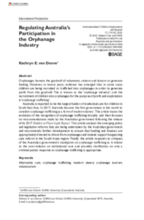Displaying 181 - 190 of 595
This study examined differences in childhood adversity, child protection involvement, and offending among crossover children by neurodisability status.
This article interrogates formal public evaluations of extended care programmes with a particular focus on their eligibility criteria that have determined which groups of care leavers are included or alternatively excluded and the identified strengths and limitations of the programmes.
"As Australians grapple with the sudden and challenging changes that COVID-19 has brought to their daily lives, the impact of the virus is being felt in extreme ways by vulnerable children and families," says Melissa Kaltner in this piece for the Conversation.
This report presents a review of published literature and consultation with current foster and kinship carers to examine impacts of COVID-19 on OOHC, highlighting the likelihood of increased service strain.
This paper utilises data generated through an ‘empowerment group’ for care‐experienced young people; it illustrates how an ecological understanding of agency, as a heuristic, might further understanding of the lives of care‐experienced young people.
In this article, the authors draw on case study data from the Australian Baby Makes 3 (BM3) programme to explore factors that promote father engagement in parenting support programmes.
This article, an auto-ethnographic collaboration between a social work professional and two care leavers, aims to address the problems with records compiled by care workers, social workers and other relevant personnel by constructing a ‘virtual archive’ consisting of several hypothetical records compiled in the style typically employed by caseworkers, which are then critiqued by the care leavers.
This paper explores the experiences of Victorian foster and kinship carers accessing timely health assessment and ongoing healthcare for a child placed in their care; identifying barriers and enablers.
This paper explores the experiences of Victorian foster and kinship carers accessing timely health assessment and ongoing healthcare for a child placed in their care; identifying barriers and enablers.
This article traces the evolution of the recognition of orphanage trafficking broadly, and then focusses on recommendations made by the Australian government following the release of its 2017 Hidden in Plain Sight Report.


